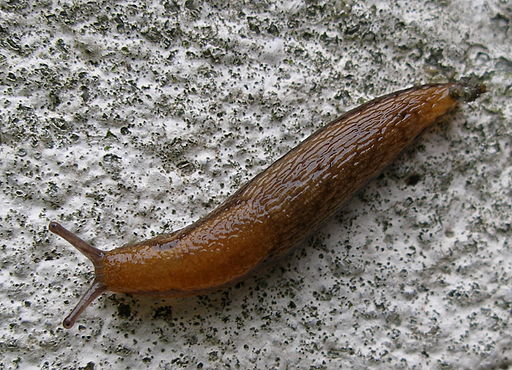SERVICE REQUEST?
Fill out the form below.
Find our nearest location
Your Local Office


Slug & Snail
Attribution: Jon Sullivan, via Wikimedia Commons
Attribution: Guttorm Flatabø, [GFDL, CC-BY-SA-3.0 or CC-BY-SA-2.5], via Wikimedia Commons
Size:
Most are small, measuring up to 1 inch. Some snails in the southern states may have shells up to 1½ inch or more. Some slugs measure up to 3 inches while others (e.g., banana slugs) in the Pacific Northwest can measure up to 10 inches when fully extended.
Color:
Varies depending on species. Usually brown, yellow or green. Some species may be black.
Behavior:
Snails and slugs are well-known and are common inhabitants around most homes not located in dry climates. Snails enclose themselves with a protective shell while slugs have no such protection. Slugs cover themselves with a slime layer that leaves a trail wherever they crawl. Both slugs and snails can be serious pests of landscape plantings, and slugs can be found crawling on floors indoors at times. On occasion, large numbers can develop around a home or other buildings resulting in numerous specimens being seen on patios, decks and even indoors. Snails and slugs are mainly nocturnal, preferring to feed in the evening or on dark days. Slugs are often found feeding on pet food left outdoors, often making it unpalatable due to the slime left behind. Both mollusks need moist conditions to survive. Some snails, however, are capable of sealing themselves within their shells and surviving up to four years waiting for conditions to improve. Natural enemies of slugs and snails include rats, mice, toads, some predacious beetles and their larvae, and wild birds.
Slugs and snails are found outside amongst vegetation and items in contact with the soil. They feed on and damage many types of plants and are seen as pests by many gardeners. Slugs, especially, can survive and thrive in damp basements and crawl spaces.
A common home remedy for slugs is the placement of shallow pans of beer. Although such “traps” will attract and capture slugs by themselves, they do little to remedy a significant slug problem. Thick ground covers, such as ivy, “monkey” grass, etc. should not be located next to or near a foundation as it provides harborage for innumerable snails, slugs, insects, spiders, mice and other pests. Items in contact with the soil should be removed, wherever possible. Exterior cracks and holes should be sealed, especially along the foundation. Weep holes can be “closed” by stuffing pieces of wire mesh or screening into the openings. Most nurseries and gardening stores sell slug and snail baits that can be applied to areas outdoors where these animals are posing a problem. When using such baits, label directions should be carefully followed.
Family Name:
Phylum Mollusca, Class Gastropoda
Read What Our Clients
Are Saying
My Terminix tech Scott is the best! He is professional, courteous and absolutely thorough about his job. Thank you for sending such a blessed tech to my house. Hamlet, NC
This letter is to say how pleased we are here at Morreene West Apartments with your services. We are very pleased with the technician, Christopher. He does a great job. Durham, NC
Terminix has consistently offered our apartment complex reliable, competent service. We are completely satisfied with their knowledgeable representative who is always punctual and does a superior job for us every time. Chapel Hill, NC
I would like to take the time to thank you for giving us such great service here at Carver Pond Apartments. Your Pest Technician Christopher Mitchell has provided us with excellent service over the last few months. Christopher is such a great help to us in providing helpful information so that we can better serve our residents here at Carver Pond. Durham, NC
SERVICE REQUEST?
Fill out the form below.